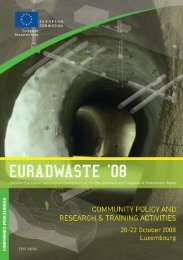EU industrial structure - EU Bookshop - Europa
EU industrial structure - EU Bookshop - Europa
EU industrial structure - EU Bookshop - Europa
You also want an ePaper? Increase the reach of your titles
YUMPU automatically turns print PDFs into web optimized ePapers that Google loves.
<strong>EU</strong> <strong>industrial</strong> <strong>structure</strong> 2011 — Trends and Performance<br />
iv24 revealed comparative advantage<br />
The third indicator of competitiveness is the index of<br />
revealed comparative advantage (RCA), which compares<br />
the share of a given sector’s exports in the <strong>EU</strong>’s total<br />
manufacturing exports with the share of the same sector’s<br />
106<br />
exports in the total manufacturing exports of a group of<br />
reference countries. Values higher (lower) than 1 mean that<br />
a given industry performs better (worse) than the reference<br />
group, and are interpreted as a sign of comparative<br />
advantage. The RCA indicator is thus used to rank <strong>EU</strong><br />
products by comparative advantage, cf. Box IV.3.<br />
box IV.3: Revealed comparative advantage (RCA) indicator<br />
The RCA indicator for product ‘i’ is defined as follows:<br />
where: X=value of exports; the reference group (‘W’) is the <strong>EU</strong>‑27 plus 142 other countries (as listed in Section<br />
IV.1.1 Goods); the source used is the UN COMTRADE database. In the calculation of RCA, X<strong>EU</strong> stands for exports to<br />
the rest of the world (excluding intra‑<strong>EU</strong> trade) and XW measures exports to the rest of the world by the countries<br />
in the reference group.<br />
IV.2.4.1 RCA In MAnUFACTURES<br />
In 2009, the <strong>EU</strong>‑27 recorded RCAs above 1.6 for industries<br />
producing printing, beverages, and tobacco products.<br />
At the bottom of the graph, computer, electronic and<br />
optical products, textiles, other manufacturing, clothing<br />
and refined petroleum have an index lower than 0.8.<br />
When interpreting the results some considerations<br />
should be taken into account: first, the level of sectoral<br />
aggregation may mask differing performance in various<br />
categories of goods within the same group of products.<br />
This is particularly relevant for industries which have<br />
a large variety of brands and quality levels for the same<br />
type of goods. Another consideration concerns country<br />
heterogeneity within the <strong>EU</strong>, as the performance of the <strong>EU</strong><br />
as a whole is explained in some cases by the performance<br />
of a few <strong>EU</strong> countries. Finally, the weight of each sector and<br />
country in the export <strong>structure</strong> of the <strong>EU</strong> should be borne<br />
in mind to get to a balanced assessment of the <strong>EU</strong>’s sectoral<br />
performance in external trade, cf. Figure IV.3.
















